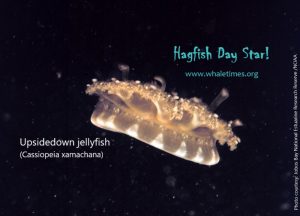Do NOT tickle the tummy of an upside-down jellyfish. (Okay, this is actually wise advice regarding any jellyfish or…well any wild animal.)
 The upside-down jellyfish (Cassiopea xamachana) follows its own path. Unlike jellyfish that float through the sea with tentacles swirling around them, the upside-down jellyfish plops on the ocean floor and holds its arms up.
The upside-down jellyfish (Cassiopea xamachana) follows its own path. Unlike jellyfish that float through the sea with tentacles swirling around them, the upside-down jellyfish plops on the ocean floor and holds its arms up.
If pestered by an animal, current, or crazed tickler, the upside-down jellyfish releases stinging snot. (Scientists would describe it as stinging structures encased in a mucus-like substance.) Inside the snot are thousands of microscopic structures with hundreds of stinging cells in each. Since upside-down jellyfish are often found in groups, if you pester one you pester them all . That means getting stung by millions of invisible venomous stingers. (Invisible without a microscope anyway).
Researchers also found upside-down jelly uses a similar kind of toxin that’s used by the deadly Australian box jellyfish (Chironex fleckeri). (Again, we’ll remind you about not tickling wild animals – especially a box jelly.)
What happens if you swim through a cloud of the stinging snot? It’ll itch, burn, , or even cause a ‘mildly painful” sting. Be thankful, though, that you’re not a brine shrimp or other small creature. The upside-down jellyfish’s snot bomb kills them instantly.
Snot bombs, slime…wonder if there’s a special meeting or club for mucous minded critters?